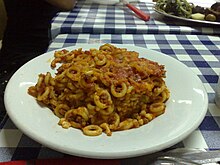Pasta al forno
 | |
| Course | Primo (Italian pasta course) |
|---|---|
| Place of origin | Italy |
Pasta al forno (lit. 'pasta to the oven', i.e. 'baked pasta') or timballo di pasta is a typical dish of Italian cuisine, made of (usually short) pasta covered with béchamel sauce, tomato sauce and cheese, and cooked in the oven.
History
[edit]Baked pasta can ideally be divided in two big categories: the version with béchamel sauce was born in the Renaissance courts of the center and north, as a poorer variant of meat pies, from which probably derive very famous dishes such as lasagne al forno and Emilian cannelloni; the so-called pasta 'nfurnata or pasta 'ncasciata is instead one of the most typical dishes of Sicily (particularly of the province of Messina, in the specific of Mistretta, and of the province of Catania) and has its origins in very ancient traditions, essentially ascribable to the sumptuous timbales that Arabs introduced in Sicily during their domination dating back to the ninth century, to which, however, is due the name timballo itself.[1][2][3]
Preparation
[edit]

For the preparation of this dish various types of short and medium cut pasta, such as rigatoni, penne, tortiglioni, ziti and maccheroni are used. If the traditional preparation of Messina imposes the use of the typical maccheroncini, the tradition of Palermo requires the use of the typical format of anelli, which give the dish an appearance similar to a flan or timballo. The pasta, cooked very al dente (lit. 'to the tooth'; it will finish cooking in the oven), drained and well mixed with the sauce, is then distributed in layers in a slightly greased baking pan or dish (or on which has been distributed a very thin layer of sauce) and alternated with ingredients linked to local traditions. In order to obtain a good quality result, it is necessary to prepare a good sauce, more or less elaborated, but with simple steps and with good quality ingredients; also in this case there are many variations according to local traditions, but generally it is made of minced beef and/or pork, after having been sautéed together with a finely chopped onion, flavored with aromatic herbs, salt and pepper and sprinkled with good red wine, tomato sauce is added and simmered for half an hour in order to allow the sauce to acquire flavor and taste.
The composition of the layers is essentially based on the classic filling of cheeses such as provola or caciocavallo cheese, sliced (mostly) cooked ham also in cubes, salami, or more frequently the typical Calabrian schiacciata or soppressata), hard-boiled eggs cut into slices or wedges and the inevitable fried meatballs. Once the distribution is finished with a last layer of pasta, to close, the whole is covered with abundant grated Parmesan cheese, in order to promote the gratinatura of the whole, and the characteristic browning and crispy curvature of the pasta in the upper layer.
The Sicilian version (pasta 'ncasciata) among its ingredients, also includes eggplants, usually cut in thin slices and fried or cubed.[4]
However, pasta can be prepared in many different ways, and there are many versions—quite common—based on white sauces with onion and minced meat or béchamel sauce, which is usually used to enhance the filling of vegetables such as artichokes or radicchio.
See also
[edit]![]() Media related to Pasta al forno at Wikimedia Commons
Media related to Pasta al forno at Wikimedia Commons
References
[edit]- ^ La cucina del Bel Paese (in Italian). Touring Club Italiano. 2003. p. 940. ISBN 88-365-2957-7.
- ^ "Gli anelletti al forno, un timballo per ogni festa e svago!". agavepalermo.com (in Italian). Archived from the original on 2018-07-06. Retrieved 2021-11-02.
- ^ "Pasta 'Ncasciata Recipe". pizzacappuccino.com.
- ^ "Pasticcio di Rigatoni alla Siciliana". la7.it. Archived from the original on 2016-06-05. Retrieved 2021-11-02.
Bibliography
[edit]- Sicilia (in Italian). Touring Club Italiano. 1989. p. 108. ISBN 88-365-0350-0.
Text is available under the CC BY-SA 4.0 license; additional terms may apply.
Images, videos and audio are available under their respective licenses.
